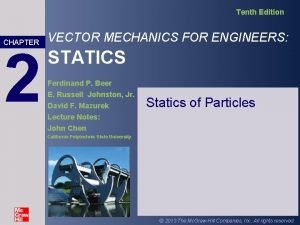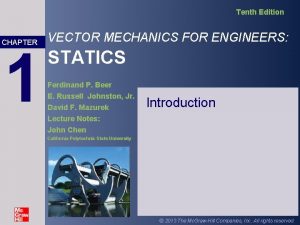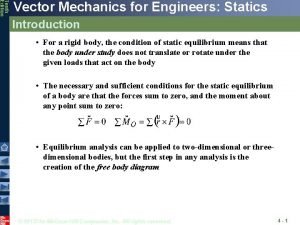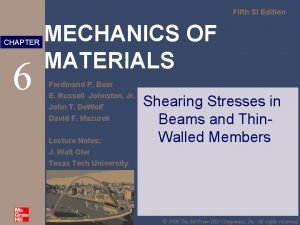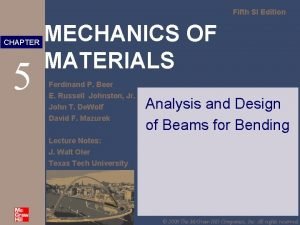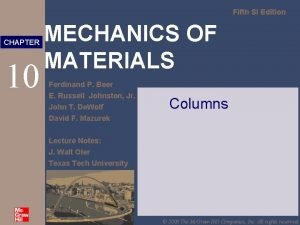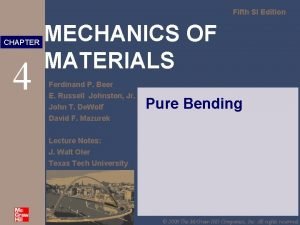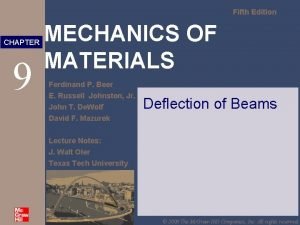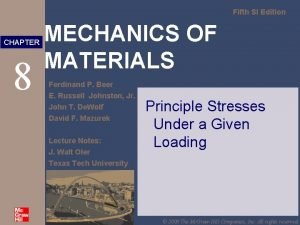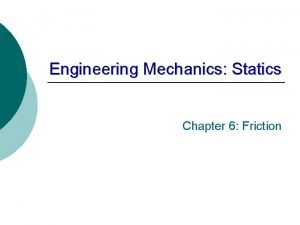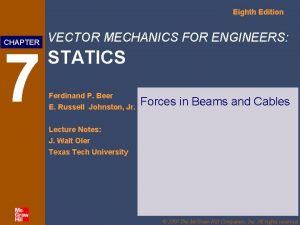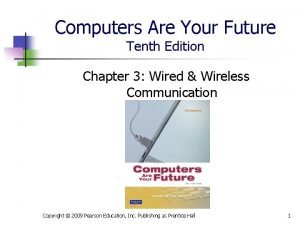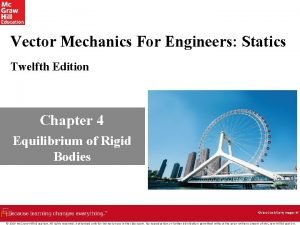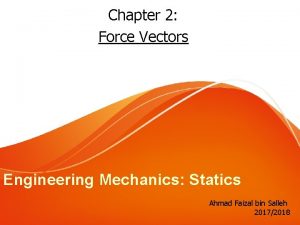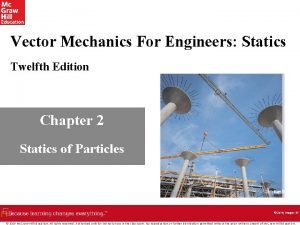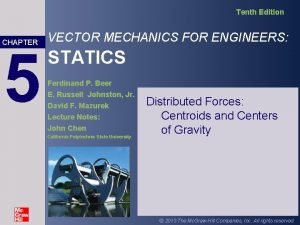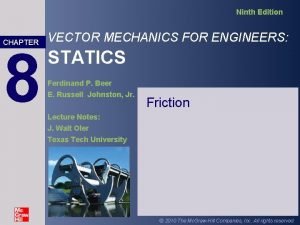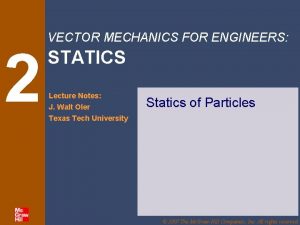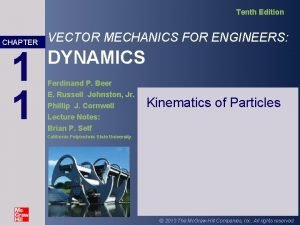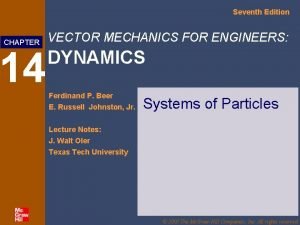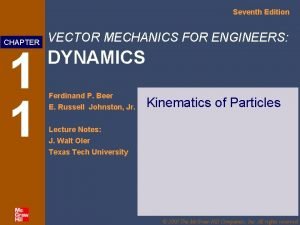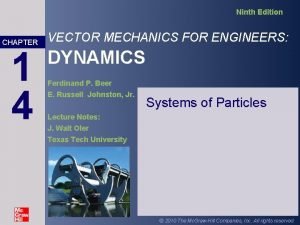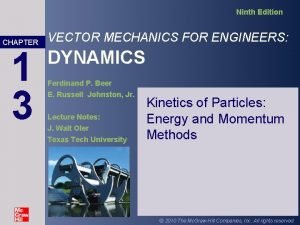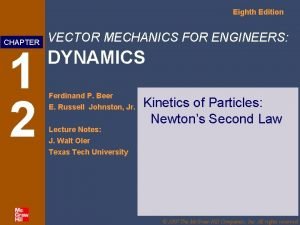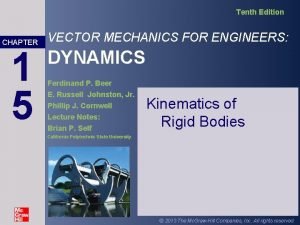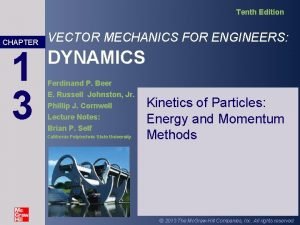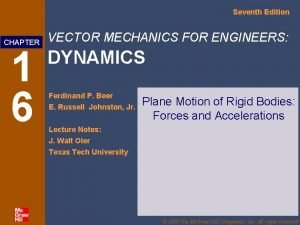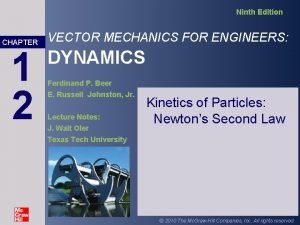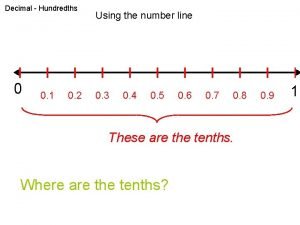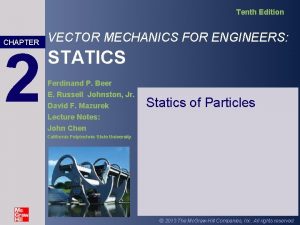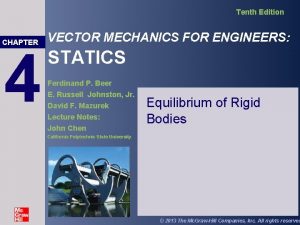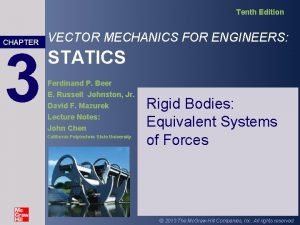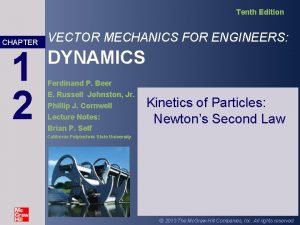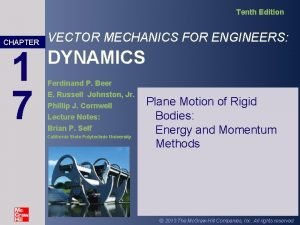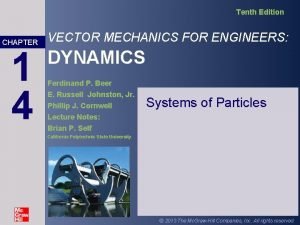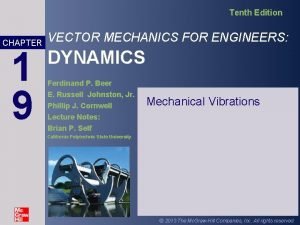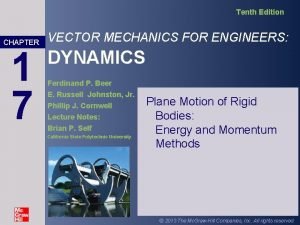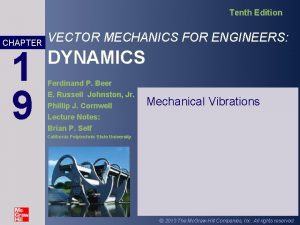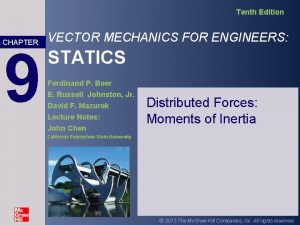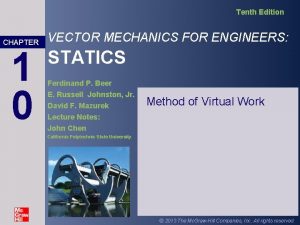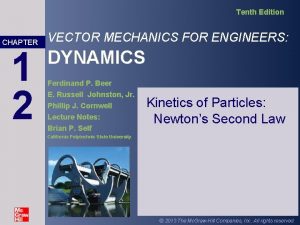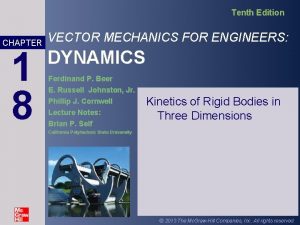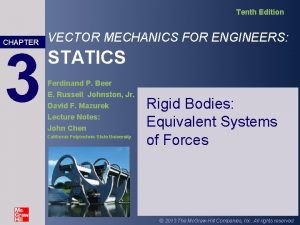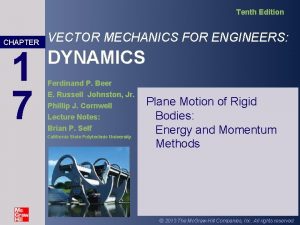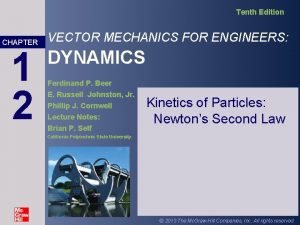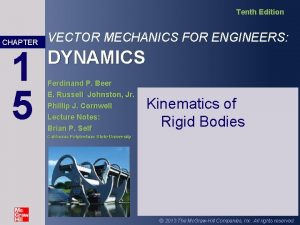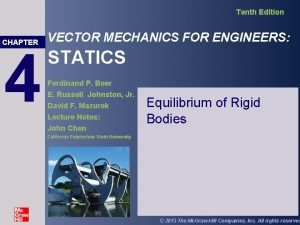Tenth Edition CHAPTER 1 6 VECTOR MECHANICS FOR



























































- Slides: 59

Tenth Edition CHAPTER 1 6 VECTOR MECHANICS FOR ENGINEERS: DYNAMICS Ferdinand P. Beer E. Russell Johnston, Jr. Phillip J. Cornwell Lecture Notes: Brian P. Self Plane Motion of Rigid Bodies: Forces and Accelerations California Polytechnic State University © 2013 The Mc. Graw-Hill Companies, Inc. All rights reserved.

Tenth Edition Vector Mechanics for Engineers: Dynamics Contents Introduction Equations of Motion of a Rigid Body Angular Momentum of a Rigid Body in Plane Motion of a Rigid Body: d’Alembert’s Principle Axioms of the Mechanics of Rigid Bodies Problems Involving the Motion of a Rigid Body Sample Problem 16. 1 Sample Problem 16. 2 © 2013 The Mc. Graw-Hill Companies, Inc. All rights reserved. Sample Problem 16. 3 Sample Problem 16. 4 Sample Problem 16. 5 Constrained Plane Motion: Noncentroidal Rotation Constrained Plane Motion: Rolling Motion Sample Problem 16. 6 Sample Problem 16. 8 Sample Problem 16. 9 Sample Problem 16. 10 16 - 2

Tenth Edition Vector Mechanics for Engineers: Dynamics Rigid Body Kinetics Early design of prosthetic legs relied heavily on kinetics. It was necessary to calculate the different kinematics, loads, and moments applied to the leg to make a safe device. © 2013 The Mc. Graw-Hill Companies, Inc. All rights reserved. The forces and moments applied to a robotic arm control the resulting kinematics, and therefore the end position and forces of the actuator at the end of the robot arm. 2 -3

Tenth Edition Vector Mechanics for Engineers: Dynamics Introduction • In this chapter and in Chapters 17 and 18, we will be concerned with the kinetics of rigid bodies, i. e. , relations between the forces acting on a rigid body, the shape and mass of the body, and the motion produced. • Results of this chapter will be restricted to: - plane motion of rigid bodies, and - rigid bodies consisting of plane slabs or bodies which are symmetrical with respect to the reference plane. • Our approach will be to consider rigid bodies as made of large numbers of particles and to use the results of Chapter 14 for the motion of systems of particles. Specifically, © 2013 The Mc. Graw-Hill Companies, Inc. All rights reserved. 16 - 4

Tenth Edition Vector Mechanics for Engineers: Dynamics Equations of Motion for a Rigid Body • Consider a rigid body acted upon by several external forces. • Assume that the body is made of a large number of particles. • For the motion of the mass center G of the body with respect to the Newtonian frame Oxyz, • For the motion of the body with respect to the centroidal frame Gx’y’z’, • System of external forces is equipollent to the system consisting of © 2013 The Mc. Graw-Hill Companies, Inc. All rights reserved. 16 - 5

Tenth Edition Vector Mechanics for Engineers: Dynamics Angular Momentum of a Rigid Body in Plane Motion • Angular momentum of the slab may be computed by • After differentiation, • Consider a rigid slab in plane motion. • Results are also valid for plane motion of bodies which are symmetrical with respect to the reference plane. • Results are not valid for asymmetrical bodies or three-dimensional motion. © 2013 The Mc. Graw-Hill Companies, Inc. All rights reserved. 16 - 6

Tenth Edition Vector Mechanics for Engineers: Dynamics Plane Motion of a Rigid Body: D’Alembert’s Principle • Motion of a rigid body in plane motion is completely defined by the resultant and moment resultant about G of the external forces. • The external forces and the collective effective forces of the slab particles are equipollent (reduce to the same resultant and moment resultant) and equivalent (have the same effect on the body). • d’Alembert’s Principle: The external forces acting on a rigid body are equivalent to the effective forces of the various particles forming the body. • The most general motion of a rigid body that is symmetrical with respect to the reference plane can be replaced by the sum of a translation and a centroidal rotation. © 2013 The Mc. Graw-Hill Companies, Inc. All rights reserved. 16 - 7

Tenth Edition Vector Mechanics for Engineers: Dynamics Axioms of the Mechanics of Rigid Bodies • The forces act at different points on a rigid body but have the same magnitude, direction, and line of action. • The forces produce the same moment about any point and are therefore, equipollent external forces. • This proves the principle of transmissibility whereas it was previously stated as an axiom. © 2013 The Mc. Graw-Hill Companies, Inc. All rights reserved. 16 - 8

Tenth Edition Vector Mechanics for Engineers: Dynamics Problems Involving the Motion of a Rigid Body • The fundamental relation between the forces acting on a rigid body in plane motion and the acceleration of its mass center and the angular acceleration of the body is illustrated in a free-body-diagram equation. • The techniques for solving problems of static equilibrium may be applied to solve problems of plane motion by utilizing - d’Alembert’s principle, or - principle of dynamic equilibrium • These techniques may also be applied to problems involving plane motion of connected rigid bodies by drawing a freebody-diagram equation for each body and solving the corresponding equations of motion simultaneously. © 2013 The Mc. Graw-Hill Companies, Inc. All rights reserved. 16 - 9

Tenth Edition Vector Mechanics for Engineers: Dynamics Free Body Diagrams and Kinetic Diagrams The free body diagram is the same as you have done in statics and in Ch 13; we will add the kinetic diagram in our dynamic analysis. 1. Isolate the body of interest (free body) 2. Draw your axis system (Cartesian, polar, path) 3. Add in applied forces (e. g. , weight) 4. Replace supports with forces (e. g. , tension force) 5. Draw appropriate dimensions (angles and distances) y x Include your positive z-axis direction too © 2013 The Mc. Graw-Hill Companies, Inc. All rights reserved. 12 - 10

Tenth Edition Vector Mechanics for Engineers: Dynamics Free Body Diagrams and Kinetic Diagrams Put the inertial terms for the body of interest on the kinetic diagram. 1. Isolate the body of interest (free body) 2. Draw in the mass times acceleration of the particle; if unknown, do this in the positive direction according to your chosen axes. For rigid bodies, also include the rotational term, IGa. © 2013 The Mc. Graw-Hill Companies, Inc. All rights reserved. 12 - 11

Tenth Edition Vector Mechanics for Engineers: Dynamics Free Body Diagrams and Kinetic Diagrams Draw the FBD and KD for the bar AB of mass m. A known force P is applied at the bottom of the bar. © 2013 The Mc. Graw-Hill Companies, Inc. All rights reserved. 2 - 12

Tenth Edition Vector Mechanics for Engineers: Dynamics Free Body Diagrams and Kinetic Diagrams y Cy A L/2 C 1. 2. 3. 4. 5. 6. x Cx Isolate body Axes Applied forces Replace supports with forces Dimensions Kinetic diagram r G G mg L/2 B P © 2013 The Mc. Graw-Hill Companies, Inc. All rights reserved. 2 - 13

Tenth Edition Vector Mechanics for Engineers: Dynamics Free Body Diagrams and Kinetic Diagrams A drum of 4 inch radius is attached to a disk of 8 inch radius. The combined drum and disk had a combined mass of 10 lbs. A cord is attached as shown, and a force of magnitude P=5 lbs is applied. The coefficients of static and kinetic friction between the wheel and ground are ms= 0. 25 and mk= 0. 20, respectively. Draw the FBD and KD for the wheel. © 2013 The Mc. Graw-Hill Companies, Inc. All rights reserved. 2 - 14

Tenth Edition Vector Mechanics for Engineers: Dynamics Free Body Diagrams and Kinetic Diagrams 1. 2. 3. 4. 5. 6. Isolate body Axes Applied forces Replace supports with forces Dimensions Kinetic diagram P 4 in = 8 in W F N y x © 2013 The Mc. Graw-Hill Companies, Inc. All rights reserved. 2 - 15

Tenth Edition Vector Mechanics for Engineers: Dynamics Free Body Diagrams and Kinetic Diagrams The ladder AB slides down the wall as shown. The wall and floor are both rough. Draw the FBD and KD for the ladder. © 2013 The Mc. Graw-Hill Companies, Inc. All rights reserved. 2 - 16

Free Body Diagrams and Kinetic Diagrams 3. Applied forces 5. Dimensions 2. Axes 4. Replace supports with forces 6. Kinetic diagram 0. 2 25 m 1. Isolate body NB q FB = m 25 0. 2 Tenth Edition Vector Mechanics for Engineers: Dynamics W y NA FA x © 2013 The Mc. Graw-Hill Companies, Inc. All rights reserved. 2 - 17

Tenth Edition Vector Mechanics for Engineers: Dynamics Sample Problem 16. 1 SOLUTION: • Calculate the acceleration during the skidding stop by assuming uniform acceleration. • Draw the free-body-diagram equation expressing the equivalence of the external and effective forces. At a forward speed of 30 ft/s, the truck • Apply the three corresponding scalar brakes were applied, causing the wheels equations to solve for the unknown to stop rotating. It was observed that the normal wheel forces at the front and rear truck to skidded to a stop in 20 ft. and the coefficient of friction between the wheels and road surface. Determine the magnitude of the normal reaction and the friction force at each wheel as the truck skidded to a stop. © 2013 The Mc. Graw-Hill Companies, Inc. All rights reserved. 16 - 18

Tenth Edition Vector Mechanics for Engineers: Dynamics Sample Problem 16. 1 SOLUTION: • Calculate the acceleration during the skidding stop by assuming uniform acceleration. • Draw a free-body-diagram equation expressing the equivalence of the external and inertial terms. • Apply the corresponding scalar equations. © 2013 The Mc. Graw-Hill Companies, Inc. All rights reserved. 16 - 19

Tenth Edition Vector Mechanics for Engineers: Dynamics Sample Problem 16. 1 • Apply the corresponding scalar equations. © 2013 The Mc. Graw-Hill Companies, Inc. All rights reserved. 16 - 20

Tenth Edition Vector Mechanics for Engineers: Dynamics Sample Problem 16. 2 SOLUTION: • Note that after the wire is cut, all particles of the plate move along parallel circular paths of radius 150 mm. The plate is in curvilinear translation. • Draw the free-body-diagram equation expressing the equivalence of the external and effective forces. The thin plate of mass 8 kg is held in place as shown. Neglecting the mass of the links, determine immediately after the wire has been cut (a) the acceleration of the plate, and (b) the force in each link. • Resolve into scalar component equations parallel and perpendicular to the path of the mass center. • Solve the component equations and the moment equation for the unknown acceleration and link forces. © 2013 The Mc. Graw-Hill Companies, Inc. All rights reserved. 16 - 21

Tenth Edition Vector Mechanics for Engineers: Dynamics Sample Problem 16. 2 SOLUTION: • Note that after the wire is cut, all particles of the plate move along parallel circular paths of radius 150 mm. The plate is in curvilinear translation. • Draw the free-body-diagram equation expressing the equivalence of the external and effective forces. • Resolve the diagram equation into components parallel and perpendicular to the path of the mass center. 60 o © 2013 The Mc. Graw-Hill Companies, Inc. All rights reserved. 16 - 22

Tenth Edition Vector Mechanics for Engineers: Dynamics Sample Problem 16. 2 • Solve the component equations and the moment equation for the unknown acceleration and link forces. 60 o © 2013 The Mc. Graw-Hill Companies, Inc. All rights reserved. 16 - 23

Tenth Edition Vector Mechanics for Engineers: Dynamics Sample Problem 16. 3 SOLUTION: • Determine the direction of rotation by evaluating the net moment on the pulley due to the two blocks. • Relate the acceleration of the blocks to the angular acceleration of the pulley. • Draw the free-body-diagram equation expressing the equivalence of the external and effective forces on the complete pulley plus blocks system. A pulley weighing 12 lb and having a radius of gyration of 8 in. is connected to • Solve the corresponding moment two blocks as shown. equation for the pulley angular Assuming no axle friction, determine the acceleration. angular acceleration of the pulley and the acceleration of each block. © 2013 The Mc. Graw-Hill Companies, Inc. All rights reserved. 16 - 24

Tenth Edition Vector Mechanics for Engineers: Dynamics Sample Problem 16. 3 SOLUTION: • Determine the direction of rotation by evaluating the net moment on the pulley due to the two blocks. rotation is counterclockwise. note: • Relate the acceleration of the blocks to the angular acceleration of the pulley. © 2013 The Mc. Graw-Hill Companies, Inc. All rights reserved. 16 - 25

Tenth Edition Vector Mechanics for Engineers: Dynamics Sample Problem 16. 3 • Draw the free-body-diagram equation expressing the equivalence of the external and effective forces on the complete pulley and blocks system. • Solve the corresponding moment equation for the pulley angular acceleration. Then, © 2013 The Mc. Graw-Hill Companies, Inc. All rights reserved. 16 - 26

Tenth Edition Vector Mechanics for Engineers: Dynamics Sample Problem 16. 4 SOLUTION: • Draw the free-body-diagram equation expressing the equivalence of the external and effective forces on the disk. A cord is wrapped around a homogeneous disk of mass 15 kg. The cord is pulled upwards with a force T = 180 N. • Solve three corresponding scalar equilibrium equations for the horizontal, vertical, and angular accelerations of the disk. • Determine the acceleration of the cord by evaluating the tangential acceleration of the point A on the disk. Determine: (a) the acceleration of the center of the disk, (b) the angular acceleration of the disk, and (c) the acceleration of the cord. © 2013 The Mc. Graw-Hill Companies, Inc. All rights reserved. 16 - 27

Tenth Edition Vector Mechanics for Engineers: Dynamics Sample Problem 16. 4 SOLUTION: • Draw the free-body-diagram equation expressing the equivalence of the external and effective forces on the disk. • Solve three scalar equilibrium equations. © 2013 The Mc. Graw-Hill Companies, Inc. All rights reserved. 16 - 28

Tenth Edition Vector Mechanics for Engineers: Dynamics Sample Problem 16. 4 • Determine the acceleration of the cord by evaluating the tangential acceleration of the point A on the disk. © 2013 The Mc. Graw-Hill Companies, Inc. All rights reserved. 16 - 29

Tenth Edition Vector Mechanics for Engineers: Dynamics Sample Problem 16. 5 SOLUTION: • Draw the free-body-diagram equation expressing the equivalence of the external and effective forces on the sphere. A uniform sphere of mass m and radius r is projected along a rough horizontal surface with a linear velocity v 0. The coefficient of kinetic friction between the sphere and the surface is mk. Determine: (a) the time t 1 at which the sphere will start rolling without sliding, and (b) the linear and angular velocities of the sphere at time t 1. © 2013 The Mc. Graw-Hill Companies, Inc. All rights reserved. • Solve three corresponding scalar equilibrium equations for the normal reaction from the surface and the linear and angular accelerations of the sphere. • Apply the kinematic relations for uniformly accelerated motion to determine the time at which the tangential velocity of the sphere at the surface is zero, i. e. , when the sphere stops sliding. 16 - 30

Tenth Edition Vector Mechanics for Engineers: Dynamics Sample Problem 16. 5 SOLUTION: • Draw the free-body-diagram equation expressing the equivalence of external and effective forces on the sphere. • Solve three scalar equilibrium equations. NOTE: As long as the sphere both rotates and slides, its linear and angular motions are uniformly accelerated. © 2013 The Mc. Graw-Hill Companies, Inc. All rights reserved. 16 - 31

Tenth Edition Vector Mechanics for Engineers: Dynamics Sample Problem 16. 5 • Apply the kinematic relations for uniformly accelerated motion to determine the time at which the tangential velocity of the sphere at the surface is zero, i. e. , when the sphere stops sliding. At the instant t 1 when the sphere stops sliding, © 2013 The Mc. Graw-Hill Companies, Inc. All rights reserved. 16 - 32

Tenth Edition Vector Mechanics for Engineers: Dynamics Group Problem Solving Knowing that the coefficient of static friction between the tires and the road is 0. 80 for the automobile shown, determine the maximum possible acceleration on a level road, assuming rearwheel drive SOLUTION: • Draw the free-body-diagram and kinetic diagram showing the equivalence of the external forces and inertial terms. • Write the equations of motion for the sum of forces and for the sum of moments. • Apply any necessary kinematic relations, then solve the resulting equations. © 2013 The Mc. Graw-Hill Companies, Inc. All rights reserved. 2 - 33

Tenth Edition Vector Mechanics for Engineers: Dynamics Group Problem Solving SOLUTION: • Given: rear wheel drive, dimensions as shown, m= 0. 80 • Find: Maximum acceleration • Draw your FBD and KD • Set up your equations of motion, realizing that at maximum acceleration, may and a will be zero y FR NR = x mg NF © 2013 The Mc. Graw-Hill Companies, Inc. All rights reserved. 2 - 34

Tenth Edition Vector Mechanics for Engineers: Dynamics • Solve the resulting equations: 4 unknowns are FR, max, NF and NR (1) (2) (4) (5)→(2) (3) (1)→(3) (5) (6) (1) and (5) and (6) →(4) Solving this equation, the masses cancel out and you get: © 2013 The Mc. Graw-Hill Companies, Inc. All rights reserved. 2 - 35

Tenth Edition Vector Mechanics for Engineers: Dynamics Group Problem Solving • Alternatively, you could have chosen to sum moments about the front wheel y FR NR = x mg NF • You can now use this equation with those on the previous slide to solve for the acceleration © 2013 The Mc. Graw-Hill Companies, Inc. All rights reserved. 2 - 36

Tenth Edition Vector Mechanics for Engineers: Dynamics Concept Question The thin pipe P and the uniform cylinder C have the same outside radius and the same mass. If they are both released from rest, which of the following statements is true? a) The pipe P will have a greater acceleration b) The cylinder C will have a greater acceleration c) The cylinder and pipe will have the same acceleration © 2013 The Mc. Graw-Hill Companies, Inc. All rights reserved. 2 - 37

Tenth Edition Vector Mechanics for Engineers: Dynamics Kinetics: Constrained Plane Motion The forces at the bottom of the pendulum depend on the pendulum mass and mass moment of inertia, as well as the pendulum kinematics. © 2013 The Mc. Graw-Hill Companies, Inc. All rights reserved. The forces one the wind turbine blades are also dependent on mass, mass moment of inertia, and kinematics. 2 - 38

Tenth Edition Vector Mechanics for Engineers: Dynamics Constrained Plane Motion • Most engineering applications involve rigid bodies which are moving under given constraints, e. g. , cranks, connecting rods, and non-slipping wheels. • Constrained plane motion: motions with definite relations between the components of acceleration of the mass center and the angular acceleration of the body. • Solution of a problem involving constrained plane motion begins with a kinematic analysis. • e. g. , given q, w, and a, find P, NA, and NB. - kinematic analysis yields - application of d’Alembert’s principle yields P, NA, and NB. © 2013 The Mc. Graw-Hill Companies, Inc. All rights reserved. 16 - 39

Tenth Edition Vector Mechanics for Engineers: Dynamics Constrained Motion: Noncentroidal Rotation • Noncentroidal rotation: motion of a body is constrained to rotate about a fixed axis that does not pass through its mass center. • Kinematic relation between the motion of the mass center G and the motion of the body about G, • The kinematic relations are used to eliminate from equations derived from d’Alembert’s principle or from the method of dynamic equilibrium. © 2013 The Mc. Graw-Hill Companies, Inc. All rights reserved. 16 - 40

Tenth Edition Vector Mechanics for Engineers: Dynamics Constrained Plane Motion: Rolling Motion • For a balanced disk constrained to roll without sliding, • Rolling, no sliding: Rolling, sliding impending: Rotating and sliding: independent • For the geometric center of an unbalanced disk, The acceleration of the mass center, © 2013 The Mc. Graw-Hill Companies, Inc. All rights reserved. 16 - 41

Tenth Edition Vector Mechanics for Engineers: Dynamics Sample Problem 16. 6 SOLUTION: • Draw the free-body-equation for AOB, expressing the equivalence of the external and effective forces. The portion AOB of the mechanism is actuated by gear D and at the instant shown has a clockwise angular velocity of 8 rad/s and a counterclockwise angular acceleration of 40 rad/s 2. Determine: a) tangential force exerted by gear D, and b) components of the reaction at shaft O. © 2013 The Mc. Graw-Hill Companies, Inc. All rights reserved. • Evaluate the external forces due to the weights of gear E and arm OB and the effective forces associated with the angular velocity and acceleration. • Solve three scalar equations derived from the free-body-equation for the tangential force at A and the horizontal and vertical components of reaction at shaft O. 16 - 42

Tenth Edition Vector Mechanics for Engineers: Dynamics Sample Problem 16. 6 SOLUTION: • Draw the free-body-equation for AOB. • Evaluate the external forces due to the weights of gear E and arm OB and the effective forces. © 2013 The Mc. Graw-Hill Companies, Inc. All rights reserved. 16 - 43

Tenth Edition Vector Mechanics for Engineers: Dynamics Sample Problem 16. 6 • Solve three scalar equations derived from the freebody-equation for the tangential force at A and the horizontal and vertical components of reaction at O. © 2013 The Mc. Graw-Hill Companies, Inc. All rights reserved. 16 - 44

Tenth Edition Vector Mechanics for Engineers: Dynamics Sample Problem 16. 8 SOLUTION: • Draw the free-body-equation for the sphere, expressing the equivalence of the external and effective forces. • With the linear and angular accelerations related, solve three scalar equations derived from the free-body-equation for the angular acceleration and the normal A sphere of weight W is released with and tangential reactions at C. no initial velocity and rolls without • Calculate the friction coefficient required slipping on the incline. for the indicated tangential reaction at C. Determine: a) the minimum value of • Calculate the velocity after 10 ft of the coefficient of friction, b) the uniformly accelerated motion. velocity of G after the sphere has rolled 10 ft and c) the velocity of G if • Assuming no friction, calculate the linear acceleration down the incline and the sphere were to move 10 ft down a corresponding velocity after 10 ft. frictionless incline. © 2013 The Mc. Graw-Hill Companies, Inc. All rights reserved. 16 - 45

Tenth Edition Vector Mechanics for Engineers: Dynamics Sample Problem 16. 8 SOLUTION: • Draw the free-body-equation for the sphere, expressing the equivalence of the external and effective forces. • With the linear and angular accelerations related, solve three scalar equations derived from the free-bodyequation for the angular acceleration and the normal and tangential reactions at C. © 2013 The Mc. Graw-Hill Companies, Inc. All rights reserved. 16 - 46

Tenth Edition Vector Mechanics for Engineers: Dynamics Sample Problem 16. 8 • Solve three scalar equations derived from the freebody-equation for the angular acceleration and the normal and tangential reactions at C. • Calculate the friction coefficient required for the indicated tangential reaction at C. © 2013 The Mc. Graw-Hill Companies, Inc. All rights reserved. 16 - 47

Tenth Edition Vector Mechanics for Engineers: Dynamics Sample Problem 16. 8 • Calculate the velocity after 10 ft of uniformly accelerated motion. • Assuming no friction, calculate the linear acceleration and the corresponding velocity after 10 ft. © 2013 The Mc. Graw-Hill Companies, Inc. All rights reserved. 16 - 48

Tenth Edition Vector Mechanics for Engineers: Dynamics Sample Problem 16. 9 SOLUTION: • Draw the free-body-equation for the wheel, expressing the equivalence of the external and effective forces. • Assuming rolling without slipping and therefore, related linear and angular accelerations, solve the scalar equations for the acceleration and the normal and tangential reactions at the ground. A cord is wrapped around the inner hub of a wheel and pulled horizontally • Compare the required tangential reaction with a force of 200 N. The wheel has to the maximum possible friction force. a mass of 50 kg and a radius of • If slipping occurs, calculate the kinetic gyration of 70 mm. Knowing ms = friction force and then solve the scalar 0. 20 and mk = 0. 15, determine the equations for the linear and angular acceleration of G and the angular accelerations. acceleration of the wheel. © 2013 The Mc. Graw-Hill Companies, Inc. All rights reserved. 16 - 49

Tenth Edition Vector Mechanics for Engineers: Dynamics Sample Problem 16. 9 SOLUTION: • Draw the free-body-equation for the wheel, . • Assuming rolling without slipping, solve the scalar equations for the acceleration and ground reactions. Assume rolling without slipping, © 2013 The Mc. Graw-Hill Companies, Inc. All rights reserved. 16 - 50

Tenth Edition Vector Mechanics for Engineers: Dynamics Sample Problem 16. 9 • Compare the required tangential reaction to the maximum possible friction force. F > Fmax , rolling without slipping is impossible. Without slipping, • Calculate the friction force with slipping and solve the scalar equations for linear and angular accelerations. © 2013 The Mc. Graw-Hill Companies, Inc. All rights reserved. 16 - 51

Tenth Edition Vector Mechanics for Engineers: Dynamics Sample Problem 16. 10 SOLUTION: • Based on the kinematics of the constrained motion, express the accelerations of A, B, and G in terms of the angular acceleration. The extremities of a 4 -ft rod weighing 50 lb can move freely and with no friction along two straight tracks. The rod is released with no velocity from the position shown. • Draw the free-body-equation for the rod, expressing the equivalence of the external and effective forces. • Solve three corresponding scalar equations for the angular acceleration and the reactions at A and B. Determine: a) the angular acceleration of the rod, and b) the reactions at A and B. © 2013 The Mc. Graw-Hill Companies, Inc. All rights reserved. 16 - 52

Tenth Edition Vector Mechanics for Engineers: Dynamics Sample Problem 16. 10 SOLUTION: • Based on the kinematics of the constrained motion, express the accelerations of A, B, and G in terms of the angular acceleration. Express the acceleration of B as With the corresponding vector triangle and the law of signs yields The acceleration of G is now obtained from Resolving into x and y components, © 2013 The Mc. Graw-Hill Companies, Inc. All rights reserved. 16 - 53

Tenth Edition Vector Mechanics for Engineers: Dynamics Sample Problem 16. 10 • Draw the free-body-equation for the rod, expressing the equivalence of the external and effective forces. • Solve three corresponding scalar equations for the angular acceleration and the reactions at A and B. 45 o © 2013 The Mc. Graw-Hill Companies, Inc. All rights reserved. 16 - 54

Tenth Edition Vector Mechanics for Engineers: Dynamics Group Problem Solving The uniform rod AB of weight W is released from rest when Assuming that the friction force between end A and the surface is large enough to prevent sliding, determine immediately after release (a) the angular acceleration of the rod, (b) the normal reaction at A, (c) the friction force at A. SOLUTION: • Draw the free-body-diagram and kinetic diagram showing the equivalence of the external forces and inertial terms. • Write the equations of motion for the sum of forces and for the sum of moments. • Apply any necessary kinematic relations, then solve the resulting equations. © 2013 The Mc. Graw-Hill Companies, Inc. All rights reserved. 2 - 55

Tenth Edition Vector Mechanics for Engineers: Dynamics Group Problem Solving • Draw your FBD and KD • Set up your equations of motion • Kinematics and solve (next page) SOLUTION: Given: WAB = W, b= 70 o • Find: a. AB, NA, Ff y L/2 W = 70 o x 70 o Ff NA © 2013 The Mc. Graw-Hill Companies, Inc. All rights reserved. 2 - 56

Tenth Edition Vector Mechanics for Engineers: Dynamics Group Problem Solving • Set up your kinematic relationships – define r. G/A, a. G L/2 70 o • Realize that you get two equations from the kinematic relationship • Substitute into the sum of forces equations © 2013 The Mc. Graw-Hill Companies, Inc. All rights reserved. 2 - 57

Tenth Edition Vector Mechanics for Engineers: Dynamics Group Problem Solving • Substitute the Ff and NA into the sum of moments equation • Masses cancel out, solve for a. AB • The negative sign means a is clockwise, which makes sense. • Subbing into NA and Ff expressions, © 2013 The Mc. Graw-Hill Companies, Inc. All rights reserved. 2 - 58

Tenth Edition Vector Mechanics for Engineers: Dynamics Concept Question What would be true if the floor was smooth and friction was zero? = 70 o NA a) The bar would rotate about point A b) The bar’s center of gravity would go straight downwards c) The bar would not have any angular acceleration © 2013 The Mc. Graw-Hill Companies, Inc. All rights reserved. 2 - 59
 Mechanics for engineers
Mechanics for engineers Vector mechanics for engineers statics 10th edition
Vector mechanics for engineers statics 10th edition Mechanics
Mechanics Vector mechanics for engineers statics 10th edition
Vector mechanics for engineers statics 10th edition Campbell biology tenth edition
Campbell biology tenth edition Campbell biology tenth edition
Campbell biology tenth edition Campbell biology tenth edition
Campbell biology tenth edition Elementary statistics tenth edition
Elementary statistics tenth edition Digital fundamentals 10th edition floyd
Digital fundamentals 10th edition floyd Corporate finance tenth edition
Corporate finance tenth edition Psychology tenth edition david g myers
Psychology tenth edition david g myers Introduction to genetic analysis tenth edition
Introduction to genetic analysis tenth edition Corporate finance tenth edition
Corporate finance tenth edition Corporate finance tenth edition
Corporate finance tenth edition Corporate finance tenth edition
Corporate finance tenth edition Corporate finance tenth edition
Corporate finance tenth edition Campbell biology tenth edition
Campbell biology tenth edition The graph shows data from the light colored soil enclosure
The graph shows data from the light colored soil enclosure Biology tenth edition
Biology tenth edition Biology tenth edition
Biology tenth edition Mechanics of materials chapter 10 solutions
Mechanics of materials chapter 10 solutions Chapter 7 beer
Chapter 7 beer Beer johnston
Beer johnston Mechanics of materials 6th edition beer solution chapter 5
Mechanics of materials 6th edition beer solution chapter 5 Mechanic of materials
Mechanic of materials Mechanic of materials
Mechanic of materials Mechanic of materials
Mechanic of materials Mechanics
Mechanics Engineering mechanics (9th) edition chapter 12 problem 30p
Engineering mechanics (9th) edition chapter 12 problem 30p Engineering mechanics chapter 2 solutions
Engineering mechanics chapter 2 solutions Vector mechanics for engineers
Vector mechanics for engineers Tenth chapter wired
Tenth chapter wired Fluid mechanics fundamentals and applications 3rd edition
Fluid mechanics fundamentals and applications 3rd edition Vector mechanics for engineers statics 12th
Vector mechanics for engineers statics 12th Force vector engineering mechanics
Force vector engineering mechanics Line of action of force
Line of action of force Vector mechanics for engineers
Vector mechanics for engineers Static mechanics
Static mechanics Vector mechanics
Vector mechanics Vector mechanics for engineers: dynamics
Vector mechanics for engineers: dynamics Vector mechanics for engineers: dynamics
Vector mechanics for engineers: dynamics Vector mechanics for engineers dynamics 12th
Vector mechanics for engineers dynamics 12th Vector mechanics for engineers: dynamics
Vector mechanics for engineers: dynamics Vector mechanics for engineers: dynamics
Vector mechanics for engineers: dynamics Vector mechanics for engineers: dynamics
Vector mechanics for engineers: dynamics Overall expression
Overall expression Vector mechanics for engineers dynamics 12th
Vector mechanics for engineers dynamics 12th Vector mechanics for engineers dynamics 12th
Vector mechanics for engineers dynamics 12th Vector mechanics for engineers dynamics 12th
Vector mechanics for engineers dynamics 12th Mis chapter 6
Mis chapter 6 Chapter 1
Chapter 1 How to find a unit vector
How to find a unit vector Coordenadas cartesianas
Coordenadas cartesianas How is vector resolution the opposite of vector addition
How is vector resolution the opposite of vector addition Meaning of position vector
Meaning of position vector The tenth man graham greene summary
The tenth man graham greene summary Hundred thousand place
Hundred thousand place 75 rounded to the nearest ten
75 rounded to the nearest ten Nearest meter
Nearest meter How many hundredths are in one tenth
How many hundredths are in one tenth
